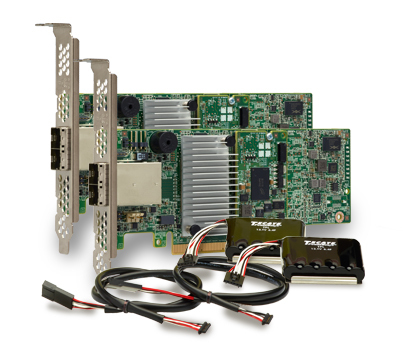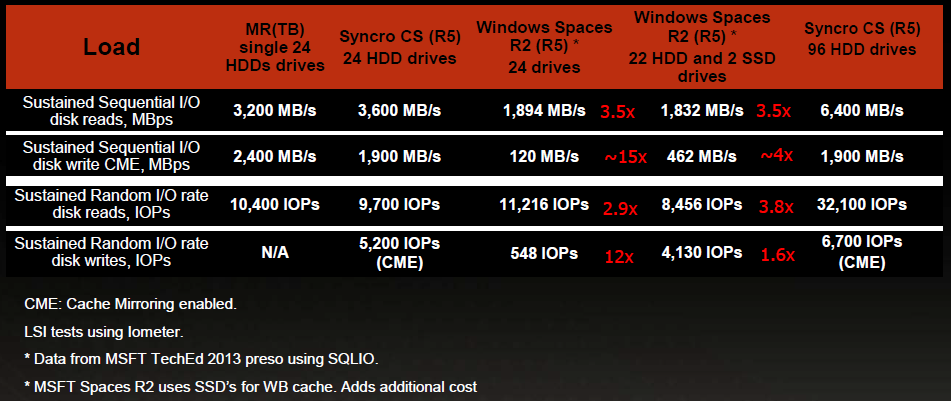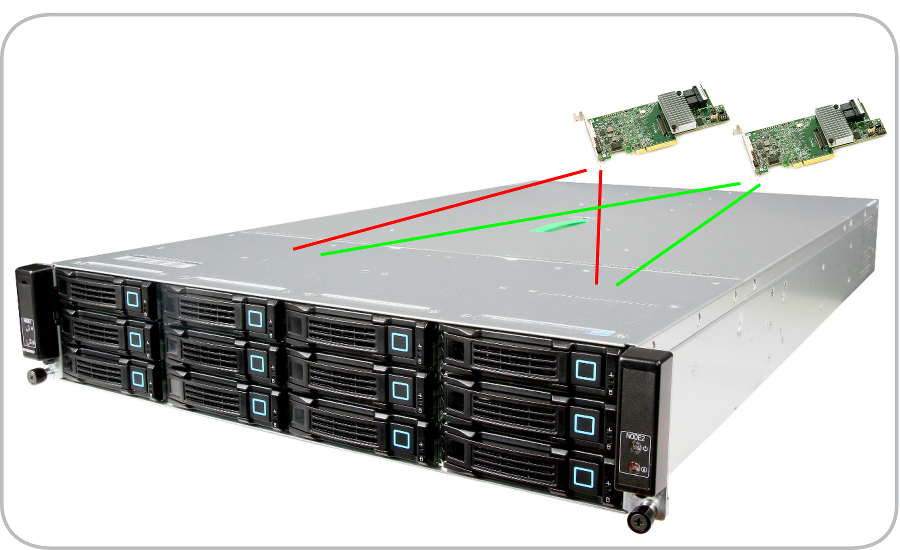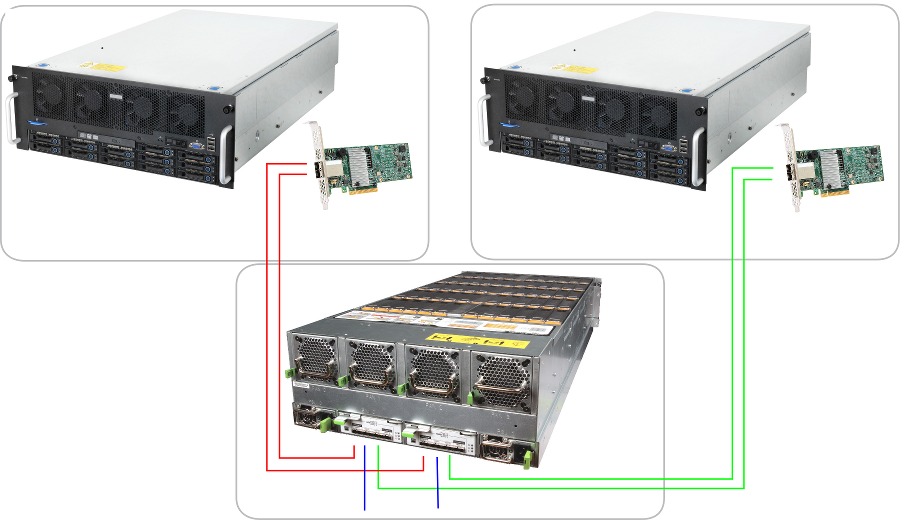Hardware Shared DAS or why LSI Syncro is needed

Shared DAS Solutions, recently gaining more and more popularity. The explanation is quite simple. There was a demand for them from the broad and very dynamic sector of the market, from small and medium-sized businesses (SMB) to the level of small enterprises. Traditional solutions with low fault tolerance have already ceased to suit them, but at the same time, the cost of traditional SAN data storage networks is too high for them. Namely, Shared DAS solutions provide high fault tolerance through the use of several data paths and low equipment costs. A nice bonus is a fairly high performance and low latency during data transfer, since SAS is used as the switching medium. Microsoft was the locomotive, offering Windows Server 2012, which included Storage Spaces,
But what to do for those for whom Storage Spaces performance is not enough, but at the same time the project size is not so large that it makes sense to talk about a full SAN? The answer is to use LSI Syncro.
Before we get into the discussion of what LSI Syncro is, let's formulate what exactly in Storage Spaces raises the main complaints:
- drives included with Storage Spaces cannot be used to boot an operating system
- the performance of virtual disks with parity (Parity or Dual Parity, which is an analogue of the well-known RAID5 and RAID6 arrays, respectively) for recording is low due to the peculiarities of the implementation of the latter
- the implementation of parity control at the software level slightly increases the load on the processor and server memory
Now let's get back to the hero of our article.
LSI Syncro is a set of two RAID controllers that communicate with each other and are able to synchronize data in the cache. Their task is to provide access to connected drives to two servers at once. In addition to the pair of controllers themselves, the delivery kit immediately includes a couple of CacheVault batteries, the task of which is to ensure the safety of data in the controllers cache in case the server remains without power.
Many people are puzzled by the fact that to ensure data coherency in the controller cache, not a dedicated data transmission medium is used, but the same SAS data transmission channels, which are also used to transfer the main data stream between controllers and expanders. But with sound thought, we can conclude that just a dedicated line for Heartbeat could become that single point of failure, and so we have a duplicated path. As for channel sharing, the traffic between the caches is not so large as to have a tangible impact on performance.

LSI Syncro, internal

design LSI Syncro, external design
Currently, the LSI Syncro product family includes 4 products: 9271-8i, 9286-8e, 9361-8i, and 9380-8e. The first two sets are SAS 6G solutions that differ in port design: on the 9271-8i, each controller has 2 internal miniSAS ports, and on the 9286-8e, two external. The recently introduced 9361-8i and 9380-8e represent a further development of the LSI Syncro family and differ from their predecessors in the transition to the SAS 12G interface. So if you consider SAS 6G already outdated or insufficiently productive and are ready to consider infrastructure only on 12G, then this will not be a problem.
Some general technical specifications:
| Supported RAID Types | 0, 1, 5, 6, 10, 50, 60 |
| The number of virtual disks per controller | up to 64 in the HA domain (High Availability domain) |
| Controller Form Factor | MD2 Low profile (6.6 "x 2.536") |
| Interface | PCI-Express v.3.0 x8 |
| Supported Devices | up to 96 SAS SSD / HDD, up to 31 SAS expander, in total up to 120 SAS devices in the HA domain |
| Working temperature | 55 ° C |
To start a detailed discussion about the possibilities of this solution is that not only the obvious Windows Server 2008 and 2012, but also Red Hat Enterprise Linux 6.3 and 6.4, SuSE Linux Enterprise Server 11 SP2 and SP3, CentOS 6.4 and 6.5 are declared as supported operating systems. , the driver for which lies on the site in the public domain. Here it is, happiness and opportunity for open source devotees.
What benefits do we get from LSI Syncro?
Performance
- Unloading the central processor and RAM by moving parity algorithms in RAID 5/6 to the processor and controller cache
- Capacious and powerful write cache with power failure protection and mirroring
If we look at the data provided by LSI, then the capabilities (or rather superiority) of LSI Syncro in the field of disk subsystem performance will look as follows:

LSI Syncro performance compared to Storage Space s
As regards the maximum performance achieved on the new generation with the SAS interface 12G, then the current firmware 2.0 - 23.0.0-0055 allows you to get from 48 SAS disks 15000 rpm in RAID0 8900 MB / s for reading and 4500 MB / s for writing. LSI knows about recording problems, they say that this is due to the unsuccessful implementation of write caching synchronization, and that the next firmware 2.2 has completely solved this problem and the write performance is the same 8900 MB / s - the performance limit of the disks themselves.
Reliability
- Platform Independence
- Data independent of server failure
- OS crash protection
- Easy and convenient construction of highly protected storage systems with duplication of all data paths
Additional features
In addition to the above, it is worth noting such an important and useful feature of LSI Syncro as the ability to create not only public cluster disk pools, but also dedicated pools for specific servers. This feature is important when building AlwaysOn Availability Groups based on MS SQL Server 2012.
In some cases, the ability to boot operating systems from disks connected to LSI Syncro will also be a valuable opportunity.
Perhaps it is worth noting the simplicity of scaling such solutions: SAS expanders support both cascading and self-configuration, which means you can expand the general pool of available drives simply by adding another inexpensive disk shelf. And with complete freedom of choice of its manufacturer.
How realistic is scaling to the stop in principle? This is not a problem: just two 60-disk shelves will allow you to completely choose the capabilities of LSI Syncro and get at your disposal a pool of 96 x 6 TB = 576 TB, that is, half a petabyte of raw disk capacity on low-cost SAS NL drives. This, of course, is less than the capabilities of modern SANs or the same Storage Spaces, but it seems to us that few among the target audience can call this insufficient scalability.
If we return to the shortcomings of Storage Spaces mentioned at the beginning of the article, it becomes obvious that the use of LSI Syncro allows you to close most of the weaknesses, expanding the general range of capabilities of Shared DAS.
Use Cases

Using LSI Syncro 9361-8i «cluster in a box" for example ETegro RS420 G4
The most obvious use case is to use LSI Syncro with internal SAS ports in cluster-in-box solutions , where LSI Syncro RAID controllers replace the adapters used to access the shared storage pool in the nodes of the SAS HBA cluster. This way we get a compact, but at the same time high-performance and fail-safe solution.
Highly accessible and efficient file server of a small company, a remote office or even a small enterprise, a database server, a web server, the basis for powerful network drives, a video processing server, a virtual environment storage server - all this can be built quickly, easily and inexpensively based on LSI Syncro.

An example of using the LSI Syncro 9380-8e with two RS530 G4 servers and a JS300 G3 disk shelf
(blue indicate SAS lines for cascading shelves)
If the computing capabilities of the “boxed” clusters are insufficient (memory is low, or the performance of two node processors is not enough), then you can take full-size servers, and here they already put LSI Syncro with external ports. And then everything is limited only by the imagination of a system architect and the possibility of cascading SAS expanders / shelves. The scope is the same as that of boxed clusters, only with a higher computational load, plus powerful data analysis and processing systems, systems for high-performance computing.
Summing up, I would like to note that the Shared DAS concept is not intended to become a panacea and replace all traditional data storage options, and the SAS interface will never replace Ethernet, FiberChannel and InfiniBand. But in many cases, when the capabilities of the SAS interface are quite sufficient in terms of scale and range, Shared DAS solutions based on LSI Syncro can be the most profitable, convenient and efficient way to store data.
